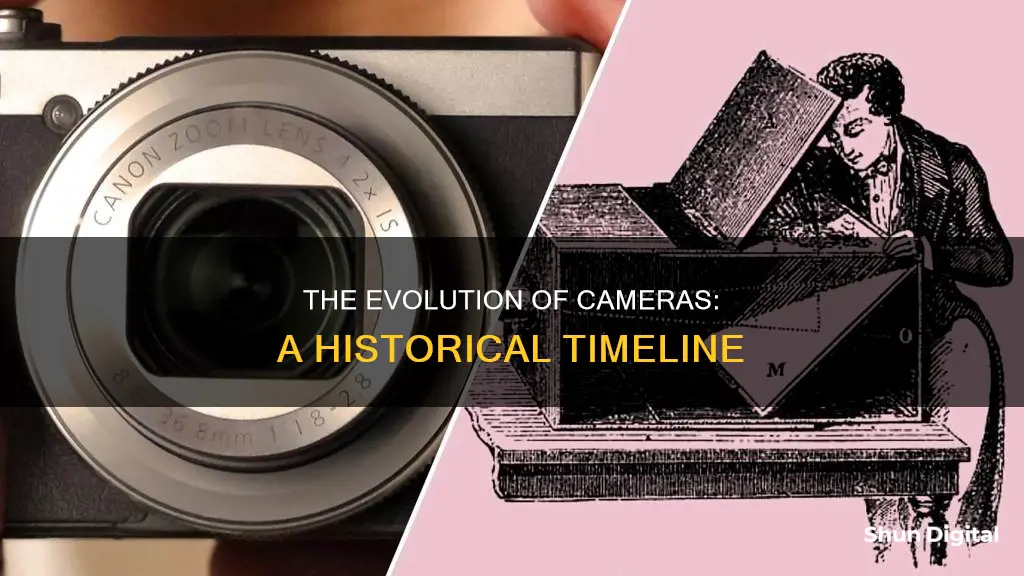
The history of cameras is a long and fascinating one, spanning centuries and involving numerous inventors and innovations. The first camera, or at least the first device that resembles what we now understand to be a camera, can be traced back to the invention of the camera obscura, which means dark room in Latin. This device, which dates back to around 400 BC, was a dark room with a small hole that projected an inverted image of the outside world onto its walls.
Over the centuries, the camera obscura evolved and, by the 16th century, lenses were being used to improve image sharpness. By the 17th century, portable versions of the camera obscura were being used as drawing tools. However, it wasn't until the early 19th century that the first permanent photograph was captured. This milestone is credited to French inventor Joseph Nicéphore Niépce, who, in 1826 or 1827, successfully projected an image onto a pewter plate coated with bitumen.
The next significant development in the history of cameras came in the form of the daguerreotype camera, invented by Louis Daguerre in 1839. This camera used a copper plate coated with silver chloride and sensitized with iodine to capture images, which were then developed using hot mercury. This process produced sharper images and reduced exposure times.
The rest, as they say, is history. The evolution of camera technology continued with the invention of roll film, 35mm film, instant cameras, digital cameras, and, eventually, the now-ubiquitous camera phone.
| Characteristics | Values |
|---|---|
| First camera | Camera obscura |
| First camera inventor | Han Chinese scholar Mozi |
| First camera invention date | 400 BC to early 1800s |
| First permanent photograph | Taken in 1826 by Joseph Nicephore Niepce |
| First photographic camera | Developed in 1816 by Joseph Nicephore Niepce |
| First photographic camera for commercial manufacture | Giroux daguerreotype camera, built in 1839 |
| First roll film | Invented in 1888 by George Eastman |
| First 35mm film | Introduced in 1934 by Kodak |
| First instant camera | Polaroid, released in 1948 |
| First point-and-shoot camera | Instamatic, released in 1963 by Kodak |
| First digital camera | Invented in 1975 by Steven Sasson |
| First camera phone | Kyocera VP-210, released in 1999 |
What You'll Learn

The first camera
The camera obscura was used for centuries, with improvements made over time. By the 16th century, rudimentary lenses were being used to improve image sharpness, and by the 17th century, portable versions of the camera obscura in tents and boxes had been developed. However, the images produced by these early cameras could not be preserved and had to be manually traced.
In the early 19th century, Joseph Nicephore Niepce used a camera obscura to capture the world's first permanent photograph. Niepce used a sliding wooden box camera made by Parisian opticians Charles and Vincent Chevalier to experiment with photography. He exposed the camera for 8 hours, using a light-sensitive substance called Bitumen of Judea, or Asphalt of Syria, to capture an image of the view from his window. He called his process "heliography", meaning "sun drawing".
While Niepce is often credited as the inventor of the first camera, it is important to note that the development of the photographic camera relied on centuries of contributions from various inventors. For example, in 1839, Louis Daguerre invented the daguerreotype, a photographic process that used iodized silver plates exposed to light and developed with mercury fumes, producing sharper images with shorter exposure times. This invention marked the beginning of commercial photography and the mass production of cameras.
The Power of Wyze Cameras: Battery or Plug-in?
You may want to see also

The first photograph
The world's oldest surviving photograph was produced by Joseph Nicéphore Niépce in 1826 or 1827. The image, a view from his estate's window, was captured using a technique Niépce invented called heliography, which produces one-of-a-kind images on metal plates treated with light-sensitive chemicals.
Niépce's photograph was taken with the first proper camera, a sliding wooden box camera made by Parisian opticians Charles and Vincent Chevalier. The photograph was created by exposing a bitumen-coated plate in the camera obscura for several hours or days. The bitumen hardened where the light was strongest, and the unhardened parts were removed to reveal an image of the streetscape outside.
The process was named "heliography" or "sun writing" by Niépce, and while the resulting image was blurred and grey-hued, it was integral to the development of modern photography.
The Evolution of Early Cameras: A Historical Perspective
You may want to see also

The first photographic camera
In 1829, Louis Daguerre invented a more efficient camera device. Daguerreotypes were images captured by Daguerre's camera, and his approach defined cameras in the mid-19th century. Daguerreotypes are created by covering a copper plate with silver, sensitizing it with iodine, then exposing it to hot mercury. Henry Fox Talbot's calotype, a daguerreotype variant, was also popular.
The first mass-marketed camera was a daguerreotype camera produced by Alphonse Giroux in 1839. It cost 400 francs (approximately $7,000 by today's standards). This consumer camera had an exposure time of 5 to 30 minutes, and you could purchase standardized plates in a range of sizes.
Charging the 808 Camera: Long First Charge Needed?
You may want to see also

The first colour photograph
Maxwell demonstrated that any visible hue or grey tone could be made by mixing only three pure colours of light – red, green and blue. To prove this, Sutton took three monochrome "colour separations" of a bow made of ribbon with stripes of various colours, using a camera and three separate red, green and blue filters. The three images were then projected onto a screen through three similarly coloured lenses, resulting in a full-colour image.
Tasco Trail Camera: Loading Batteries for Optimum Performance
You may want to see also

The first digital camera
The CCD, invented in 1969, was a breakthrough that allowed digital photography to take off. A CCD is a light sensor that sits behind the lens and captures the image, taking the place of the film in the camera. The first cameras to use CCD sensors were specialist industry models made by Fairchild in the 1970s.
Sasson's prototype digital camera was not intended to be a commercial product. In fact, Kodak did not see a market for digital cameras and continued to focus on film photography. However, the invention of the first digital camera paved the way for the development of smaller, more multifunctional, and convenient cameras that we use today.
Mastering Camera Raw Color Correction Techniques
You may want to see also
Frequently asked questions
The first camera, the camera obscura, was made around 400 BC. However, the first photographic camera was developed in 1816 by Joseph Nicéphore Niépce.
The invention of the camera was a long process that involved many people. However, the first photographic camera is credited to Joseph Nicéphore Niépce, who took the first photograph in 1826.
The first camera was a large, portable box camera made of wood. It used a pewter plate coated with bitumen, which hardened when exposed to light. Niépce's camera produced blurry images that lacked clarity and depth.







